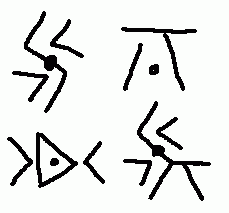Gaeran Common
So tonight I've been working on something and threw together the rough workings for a Common alphabet, system of numerals, and punctuation symbols.

Most notable about this? I turned it into a downloadable font for the PC.
A sample of what it looks like in action:

Some linguistic BS: The symbol for $ is intended to be a half-assed combination of the D and G letters, a bastardization and shortcut by hasty merchants for the "DG" or Doman gil. Likewise, the @ symbol is a combination of the A and T letters, another mercantile shortcut for writing things like "6 chickens @ 35 gil ea." The & symbol I derived from the letters for E and T in a fabulous bit of linguistic nonsense (the & sign was theoretically originally a shortcut for the Latin "et," for "and"). While et was probably never the word for and in Common, per se, it's a decent character unless there's a better idea, as it's unmistakeable and quick to write.
All of the letters are intended to be carveable into stone, which is why there are no curves. Initially, I included more "dots" in some of the characters, like the D, G, S, and X. However, Ashley and I decided that lazy carvers/writers would probably eventually stop using them anyway, so I dropped them since their initial purpose was to make the letters look more different from English.
An interesting note is that this means speakers of English might have relatively little trouble learning the written alphabet, because it looks vaguely like English writing, but I think it's fair to assume that since the language itself is different, this is just the alphabet--obviously, the grammar and vocabulary would not be the same.
Edit:

Hakaril's arcane rune, not that it's technically part of the alphabet--it's just derived from the letters for HS, and he uses it as a signature instead of writing his name as a general rule. Included just for fun.

Most notable about this? I turned it into a downloadable font for the PC.
A sample of what it looks like in action:

Some linguistic BS: The symbol for $ is intended to be a half-assed combination of the D and G letters, a bastardization and shortcut by hasty merchants for the "DG" or Doman gil. Likewise, the @ symbol is a combination of the A and T letters, another mercantile shortcut for writing things like "6 chickens @ 35 gil ea." The & symbol I derived from the letters for E and T in a fabulous bit of linguistic nonsense (the & sign was theoretically originally a shortcut for the Latin "et," for "and"). While et was probably never the word for and in Common, per se, it's a decent character unless there's a better idea, as it's unmistakeable and quick to write.
All of the letters are intended to be carveable into stone, which is why there are no curves. Initially, I included more "dots" in some of the characters, like the D, G, S, and X. However, Ashley and I decided that lazy carvers/writers would probably eventually stop using them anyway, so I dropped them since their initial purpose was to make the letters look more different from English.
An interesting note is that this means speakers of English might have relatively little trouble learning the written alphabet, because it looks vaguely like English writing, but I think it's fair to assume that since the language itself is different, this is just the alphabet--obviously, the grammar and vocabulary would not be the same.
Edit:

Hakaril's arcane rune, not that it's technically part of the alphabet--it's just derived from the letters for HS, and he uses it as a signature instead of writing his name as a general rule. Included just for fun.
